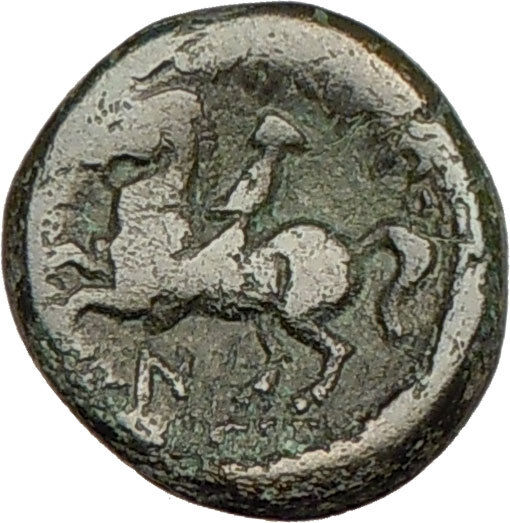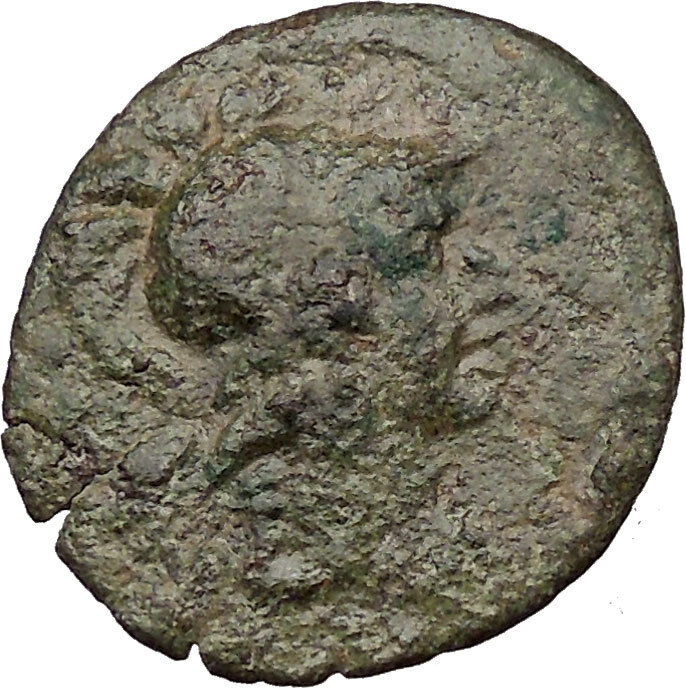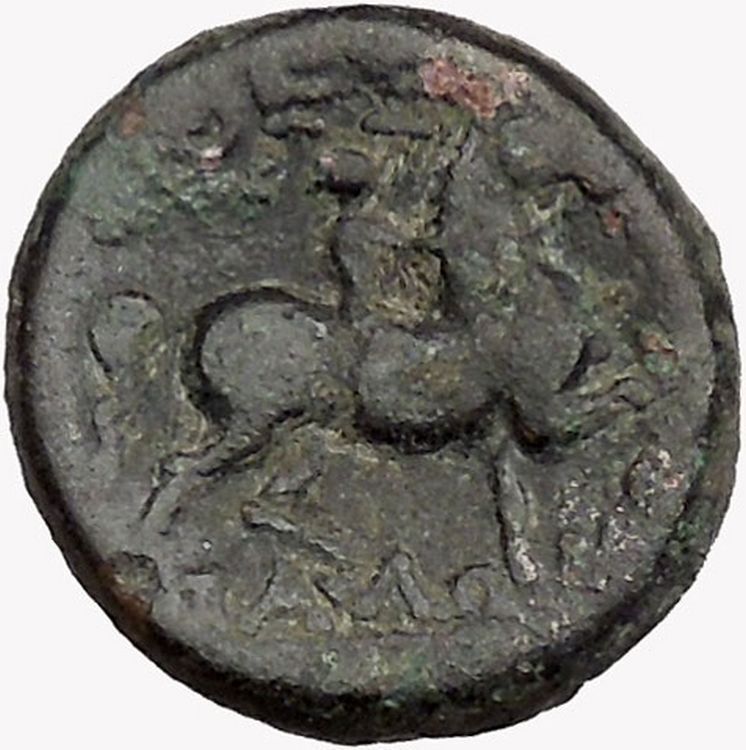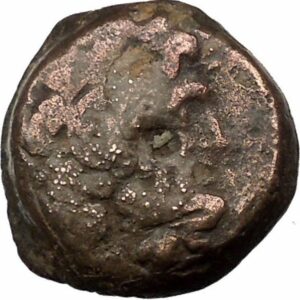|
Greek coin of Etenna in Pisidia
Bronze 17mm Struck circa 1st Century B.C.
Reference: Sear 5459; B.M.C. 19.220,2-3; Von Aulock, Pisidien, II, 425-459; SNG von Aulock 5017
Certification: NGC Ancients Ch VF 4933672-012
Two young naked people, going left, one holding a knife, the other an ax.
ET-EN either side of girl standing right, head left, pushing away an attacking snake.
Exact site of Etenna is uncertain, but probably in the vicinity of Kotenna, north of Side. The two scenes evoke the myth of the founding of the city: a young girl fetching water, attacked by a snake, was rescued by two young men who wanted to kill the snake, when it turned out to be a god. The union of the snake and the girl is from the race of Etennéens.
You are bidding on the exact item pictured, provided with a Certificate of Authenticity and Lifetime Guarantee of Authenticity.
Etenna (Ancient Greek: Ἔτεννα) was a city in the late Roman province of Pamphylia Prima. Centuries earlier, it was reckoned as belonging to Pisidia, as by Polybius, who wrote that in 218 BC the people of Etenna “who live in the highlands of Pisidia above Side” provided 8000 hoplites to assist the Seleucid usurper Achaeus.
On the basis of the preponderance of locally minted coins Etenna and the presence of potsherds of the Classical period in Greece, unusual inland elsewhere, Etenna has been identified with the rather nondescript ruins on a steep hillslope 250-500 metres north of the modern village of Sirt, which lies north of Manavgat, Antalya Province, Turkey. They have not been systematically excavated, but include remains of city walls, a roofed reservoir, baths, two basilicas, a church and rock tombs.
The identification of Etenna with Gölcük, near the modern village of Sarraçlı, further east beyond the river Melas, is considered less likely.
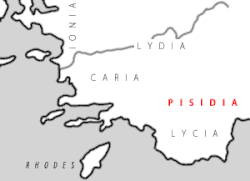 Pisidia was a region of ancient Asia Minor located north of Lycia, bordering Caria, Lydia, Phrygia and Pamphylia, and corresponding roughly to the modern-day province of Antalya in Turkey. Among Pisidia’s settlements were Termessus, Selge, Cremna, Sagalassos, Etenna, Antiochia, Neapolis, Tyriacum, Laodiceia Katakekaumene and Philomelium. Pisidia was a region of ancient Asia Minor located north of Lycia, bordering Caria, Lydia, Phrygia and Pamphylia, and corresponding roughly to the modern-day province of Antalya in Turkey. Among Pisidia’s settlements were Termessus, Selge, Cremna, Sagalassos, Etenna, Antiochia, Neapolis, Tyriacum, Laodiceia Katakekaumene and Philomelium.
Geography
Although close to Mediterranean Sea on the map, the warm climate of the south cannot pass the height of the Taurus Mountains. Owing to the climate, there is no timberland but crop plants grow in areas provided with water from the mountains, whose annual average rainfall is c. 1000 mm on the peaks and 500 mm on the slopes. This water feeds the plateau. The Pisidian cities, mostly founded on the slopes, benefited from this fertility. The irrigated soil of the land is very suitable for growing fruit and for husbandry.
History
Early history
The area of Pisidia has been inhabited since the Paleolithic age, with some settlements known from historical times ranging in age from the eighth to third millennium BC. The ancestors of the classical Pisidians were likely present in the region before the 14th century BC, when Hittite records refer to a mountain site of Salawassa, identified with the later site of Sagalassos. At that time, Pisidia appears to have been part of the region the Hittites called Arzawa. The Pisidian language is poorly known, but is assumed to be a member of the Anatolian branch of Indo-European languages.
Herodotus mentioned the Pisidic people in the text which they were called “Lakuna” but this was one of the names given to Pisidic tribes, which occupied a little mountainous region north to the Antalya Bay. Pisidians are known to be among the nations which helped the Persians in their war against Greece.
There can be little doubt that the Pisidians and Pamphylians were the same people, but the distinction between the two seems to have been established at an early period. Herodotus, who does not mention the Pisidians, enumerates the Pamphylians among the nations of Asia Minor, while Ephorus mentions them both, correctly including the one among the nations on the interior, the other among those of the coast. Pamphylia early received colonies from Greece and other lands, and from this cause, combined with the greater fertility of their territory, became more civilized than its neighbor in the interior. Pisidia remained a wild, mountainous region, and one of the most difficult for outside powers to rule.
As far back as the Hittite period, Pisidia was host to independent communities not under the Hittite yoke. Known for its warlike factions, it remained largely independent of the Lydians, and even the Persians, who conquered Anatolia in the 6th century BC, and divided the area into satrapies for greater control, were unable to cope with constant uprisings and turmoil.
Hellenistic period
Alexander the Great had somewhat better fortune, conquering Sagalassos on his way to Persia, though the city of Termessos defied him. After Alexander died, the region became part of territories of Antigonus Monophthalmus, and possibly Lysimachus of Thrace, after which Seleucus I Nicator, founder of the Seleucid Dynasty of Syria, took control of Pisidia. Under the Selucids Greek colonies were founded at strategically important places and the local people Hellenised. Even so, the Hellenistic kings were never in complete control, in part because Anatolia was contested between the Selucids, the Attalids of Pergamon, and the Galatians, invading Celts from Europe. The cities in Pisidia were among the last in western Anatolia to fully adopt Greek culture and to coin their own money.
Pisidia officially passed from the Selucids to the Attalids as a result of the Treaty of Apamea, forced on Antiochos III of Syria by the Romans in 188 BC. After Attalos III, the last king of Pergamon, bequeathed his kingdom to Rome in 133 BC as the province of Asia, Pisidia was given to the Kingdom of Cappadocia, which proved unable to govern it. The Pisidians cast their lot with pirate-dominated Cilicia and Pamphylia until Roman rule was restored in 102 BC.
In 39 BC Marcus Antonius entrusted Pisidia to the Galatian client king Amyntas and charged him with putting down the bandit Homonadesians of the Taurus Mountains, who threatened the roads connecting Pisidia to Pamphylia. After Amyntas was killed in the struggle 25 BC, Rome made Pisidia part of the new province of Galatia. The Homonadesians were finally wiped out in 3 BC.
Roman and Byzantine period
During the Roman period Pisidia was colonized with veterans of its legions to maintain control. For the colonists, who came from poorer parts of Italy, agriculture must have been the area’s main attraction. Under Augustus, eight such colonies were established in Pisidia, and Antioch and Sagalassos became the most important cities. The province was gradually Latinised. Latin remained the formal language of the area until the end of the 3rd century.
Pisidia became an important early Christian centre. Paul the Apostle preached in Antioch on his first journey and visited the area again in his second and third journeys. After the Emperor Constantine’s legalization of Christianity in 311, Antioch played an important role as the Christian metropolitan see as well as being the capital of the civil province of Pisidia. Most Pisidian cities were heavily fortified at that time due to civil wars and foreign invasions.
The area was devastated by an earthquake in 518, a plague around 541-543, and another earthquake and Arab raids in the middle of the 7th century. After the Muslim conquest of Syria disrupted the trade routes, the area declined in importance. In the 8th century the raids increased. In the 11th century the Seljuk Turks captured the area and founded the Seljuk Sultanate in Central Anatolia. Pisidia frequently changed hands between the Byzantine Empire and the Turks until 1176, when Sultan Kılıçarslan defeated Manuel Komnenos in the Battle of Myriocephalon (thousand heads), which ended Byzantine rule and cemented Turkish rule of the area.
|









 Pisidia was a region of ancient Asia Minor located north of Lycia, bordering Caria, Lydia, Phrygia and Pamphylia, and corresponding roughly to the modern-day province of Antalya in Turkey. Among Pisidia’s settlements were Termessus, Selge, Cremna, Sagalassos, Etenna, Antiochia, Neapolis, Tyriacum, Laodiceia Katakekaumene and Philomelium.
Pisidia was a region of ancient Asia Minor located north of Lycia, bordering Caria, Lydia, Phrygia and Pamphylia, and corresponding roughly to the modern-day province of Antalya in Turkey. Among Pisidia’s settlements were Termessus, Selge, Cremna, Sagalassos, Etenna, Antiochia, Neapolis, Tyriacum, Laodiceia Katakekaumene and Philomelium.

